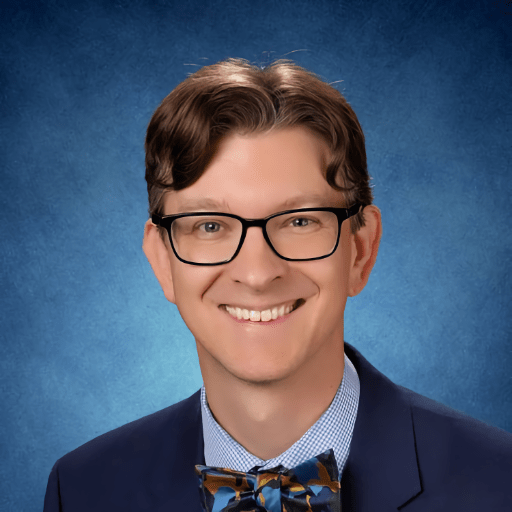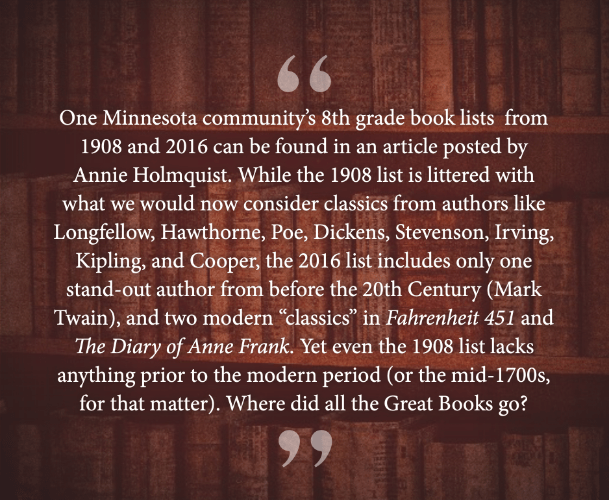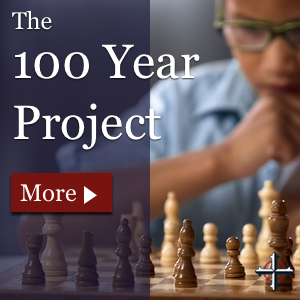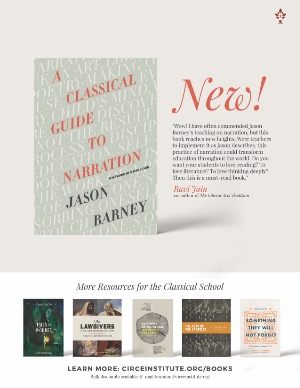When it comes to educational comparisons, even classical types might fall for the old fallacy of “chronological snobbery,” as C.S. Lewis called it.[1] In the classical world we readily accept that newer does not equal better, but we sometimes forget the complementary reverse, that older things aren’t inherently better than newer things. Thankfully, we can lean on generations of teachers and learners to help us choose the best books.

Too much attention has been paid to the languages, literature and history of classical antiquity, which were all of far less than doubtful value to the youth of twentieth-century America. The thing now was to introduce the sciences, living languages and the useful arts, to make instruction vocational, to open all manner of opportunities for vocational study, and to induce youth into our institutions for pretty strictly vocational purposes.[2]
The dominoes surrounding this mentality predictably fell, and within a very short period of time, education as it was once known in the U.S. (and the West) rode off into the sunset. Nock’s book, The Theory of Education in the United States, explains the fallout and failure as viewed from the leading edge of the change—like the Jews returned from exile who wept at the memory of the temple’s former glory. “Yet after three decades of this,” says Nock, “our system gives no better satisfaction, apparently, than it did before.”[3]
Yes, yes, we kept saying, let us but just install this one new method in the secondary schools, or this one new set of curricular changes in the under- graduate college, or this one grand new scheme for broadening the scope of university instruction, and in a year or so it will prove itself to be the very thing we have all along been needing; and this, that or the other batch of pedagogical problems will be laid to eternal rest.[4]
The trouble, of course, was that our pedagogical prob- lems were just beginning. Fast forward nine decades. A number of comparisons have surfaced between the curricula of today and the curricula of 100 years ago (or more), and the differences both amuse and convict.
Suffice it to say, modern exit exams could not hold a candle to this Kentucky test from the year the Titanic sank to the bottom of the Atlantic (which those students could locate on a map much more readily than today’s). For that matter, Oregon recently made headlines for extending their suspension of high-school exit exams altogether.[6] Unfortunately, assessments present the risky possibility of, well, assessing. We might not want to know how well we’ve been instructed (not to be confused with educated, says Nock).
We might be tempted to long for the “good ol’ days.” But when we do this, we haven’t fully appreciated the categorical difference between a classical and a contemporary education. While it’s true that many more of the books from 1908 survive as “classics” to our day, they were still quite contemporary for the time. Nock helps us recognize that in 1908—the early days of Progressive educational reforms—the bias already tilted towards “recent” works. It’s just that those (classically educated) authors still reflected the fruit of their education before it had been stripped away. How many of today’s names will we recognize as “classics” in 100 years?
The same year Nock delivered his speeches, the New York Times published its first “Best Sellers” list, and it has created controversy ever since.[9] For almost 100 years, these lists have included the latest and greatest books available to contemporary readers. But something has been left out of those numbers—classic literature.[10] Like the ideals it drives, the Times reflects an underlying worldview that rejects the riches of the Western canon in favor of contemporary thought, even in its book lists.
So, while comparisons between the modern book lists at the beginning of the Progressive era and those of our day may be amusing, they really only help us put the value of a classical Christian education in perspective all the more. When your children read Homer, Virgil, Dante, Milton, Aristotle, Augustine, Shakespeare, and even more recent authors like Dickens, Twain, Stowe, Orwell, Lewis, and Tolkien, they find themselves stepping into a Great Tradition and Conversation that outlives current events and considerations, yet incredibly enfolds them all the same.
We can, and we ought, to do better than trade new modern with merely older modern. Pick up a generations-tested classic with your kids, and discover just how much more relevant a timeless tale is than the most “relevant” modern attempt. And you might want to throw out those public library lists and trade them for one from your nearest classical Christian school. ✤
 BILL STUTZMAN is Headmaster of Classical Christian Academy in Rathdrum, ID. He has worked as a teacher and an administrator in classical Christian education for over 20 years, and served as a host for the Repairing the Ruins Conferences in 2020-2022.
BILL STUTZMAN is Headmaster of Classical Christian Academy in Rathdrum, ID. He has worked as a teacher and an administrator in classical Christian education for over 20 years, and served as a host for the Repairing the Ruins Conferences in 2020-2022.2Albert J. Nock, The Theory of Education in the United States. Mises Institute: Auburn, Alabama (2007), 11.
3Ibid, 12.,
4Ibid, 13.
5https://www.bullittcountyhistory.com/bchistory/schoolexam1912.html
6https://thehill.com/opinion/education/4288044-oregon-just-dropped-all- graduation-standards-failing-all-of-its-students-in-the-name-of-equity/
7https://intellectualtakeout.org/2016/07/middle-school-reading-lists-100-years-ago-vs-today/
8https://www.ala.org/alsc/publications-resources/book-lists
9https:/ / archive.org/details/nytimesbestsellerlist-oct121931
10Cowles, Gregory (June 2, 2013). “Inside the List”. The New York Times Book Review, cited in https://en.wikipedia.org/wiki/The_New_York_Times_Best_Seller_list#cite_ref-13













